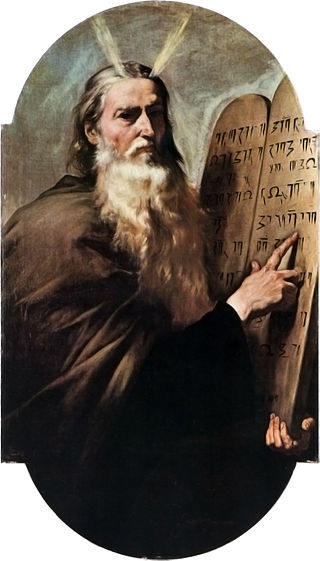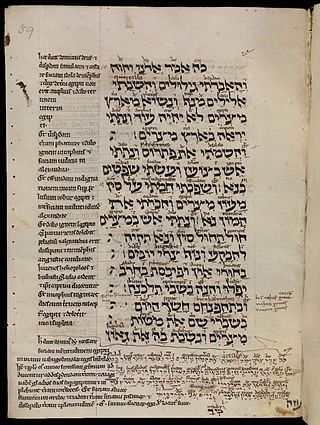The Book of Daniel is a biblical apocalypse authored during the 2nd century BC, and set during the 6th century BC. The work describes "the activities and visions of Daniel, a noble Jew exiled at Babylon"; in doing so, it interpolates a portrayal of a historical prophecy being fulfilled with a prediction of future cosmic and political upheaval. This eschatology ultimately affirms that the God of Israel's previous deliverance of Daniel from his enemies prefigures his future deliverance of the people of Israel from their present oppression.
The Book of Habakkuk is the eighth book of the 12 minor prophets of the Bible. It is attributed to the prophet Habakkuk, and was probably composed in the late 7th century BC. The original text was written in the Hebrew language.
The Old Testament (OT) is the first division of the Christian biblical canon, which is based primarily upon the 24 books of the Hebrew Bible, or Tanakh, a collection of ancient religious Hebrew and occasionally Aramaic writings by the Israelites. The second division of Christian Bibles is the New Testament, written in Koine Greek.

The documentary hypothesis (DH) is one of the models used by biblical scholars to explain the origins and composition of the Torah. A version of the documentary hypothesis, frequently identified with the German scholar Julius Wellhausen, was almost universally accepted for most of the 20th century. It posited that the Pentateuch is a compilation of four originally independent documents: the Jahwist (J), Elohist (E), Deuteronomist (D), and Priestly (P) sources. The first of these, J, was dated to the Solomonic period. E was dated somewhat later, in the 9th century BCE, and D was dated just before the reign of King Josiah, in the 7th or 8th century BCE. Finally, P was generally dated to the time of Ezra in the 5th century BCE. The sources would have been joined at various points in time by a series of editors or "redactors".
A sin offering is a sacrificial offering described and commanded in the Torah ; it could be fine flour or a proper animal. A sin offering also occurs in 2 Chronicles 29:21 where seven bulls, seven rams, seven lambs and seven he-goats were sacrificed on the command of King Hezekiah for the kingdom, for the sanctuary, and for Judah. Like all types of sacrifices offered on the altar, the flour had to be unscented and the animal had to be completely unblemished. This offered sacrifice accompanied the important required core means of atonement for the committing of an unintentional transgression of a prohibition, that either has brought guilt upon the 'community of Israel' or the individual. This offering is brought during or after atonement for those transgressions that had been committed inadvertently, or in ignorance: intentional transgressions could only be absolved by other forms of atonement, or in severe cases kareth. It was distinct from the biblical guilt offering.
The Minor Prophets or Twelve Prophets, occasionally Book of the Twelve, is a collection of prophetic books, written between about the 8th and 4th centuries BCE, which are in both the Jewish Tanakh and Christian Old Testament.
The oldest surviving Hebrew Bible manuscripts, the Dead Sea Scrolls, date to c. the 2nd century BCE. Some of these scrolls are presently stored at the Shrine of the Book in Jerusalem. The oldest text of the entire Bible, including the New Testament, is the Codex Sinaiticus dating from the 4th century CE, with its Old Testament a copy of a Greek translation known as the Septuagint. The oldest extant manuscripts of the vocalized Masoretic Text date to the 9th century CE. With the exception of a few biblical sections in the Nevi'im, virtually no biblical text is contemporaneous with the events it describes.
In the Hebrew Bible, Oholah (אהלה) and Oholibah (אהליבה) are pejorative personifications given by the prophet Ezekiel to the cities of Samaria in the Kingdom of Israel and Jerusalem in the kingdom of Judah, respectively. They appear in chapter 23 of the Book of Ezekiel.
In literature, redaction is a form of editing in which multiple sources of texts are combined and altered slightly to make a single document. Often this is a method of collecting a series of writings on a similar theme and creating a definitive and coherent work.
Daniel 8 is the eighth chapter of the Book of Daniel. It tells of Daniel's vision of a two-horned ram destroyed by a one-horned goat, followed by the history of the "little horn", which is Daniel's code-word for the Greek king Antiochus IV Epiphanes.

Mosaic authorship is the Judeo-Christian tradition that the Torah, the first five books of the Hebrew Bible/Old Testament, were dictated by God to Moses. The tradition probably began with the legalistic code of the Book of Deuteronomy and was then gradually extended until Moses, as the central character, came to be regarded not just as the mediator of law but as author of both laws and narrative.
Amy-Jill Levine is Rabbi Stanley M. Kessler Distinguished Professor of New Testament and Jewish Studies at Hartford International University for Religion and Peace. She works in biblical studies and is a critic of antisemitic, sexist, and homophobic theologies.
David John Alfred Clines was a biblical scholar. He served as professor at the University of Sheffield.
Adele Berlin is an American biblical scholar and Hebraist. Before her retirement, she was Robert H. Smith Professor of Biblical Studies at the University of Maryland.

Jacob L. Wright is a biblical scholar currently serving as professor of Hebrew Bible at Emory University. Prior to his Emory appointment, Wright taught at the University of Heidelberg (Germany), one of the foremost research-oriented public universities in Europe, for several years. His areas of expertise include Biblical Archaeology, warfare in the Ancient Near East, and the literary and redaction history of the Hebrew Bible canon. He has published extensively throughout his career, authoring several books and dozens of articles which span topics such as Ezra-Nehemiah, the Persian period, warfare in the Ancient Near East; as well as the material culture of the ancient Levant, the unique role of women in the Hebrew Bible, and larger themes such as defeat, peoplehood, and national identity in the Hebrew Bible. Areas of concentration in war studies include war commemoration, urbicide and ritual violence, and feasting and gift-giving.

Daniel 1 tells how Daniel and his three companions were among captives taken by Nebuchadnezzar II from Jerusalem to Babylon to be trained in Babylonian wisdom. There they refused to take food and wine from the king and were given knowledge and insight into dreams and visions by God, and at the end of their training they proved ten times better than all the magicians and enchanters in the kingdom.

Ezekiel 6 is the sixth chapter of the Book of Ezekiel in the Hebrew Bible or the Old Testament of the Christian Bible. This book contains the prophecies attributed to the prophet/priest Ezekiel, and is one of the Books of the Prophets. The high places in the mountains of Israel, "the seats of her idolatry", are the focus of Ezekiel's prophecies in this chapter.

Ezekiel 23 is the twenty-third chapter of the Book of Ezekiel in the Hebrew Bible or the Old Testament of the Christian Bible. This book contains the prophecies attributed to the prophet/priest Ezekiel, and is one of the Books of the Prophets. This chapter forms part of a series of "predictions regarding the fall of Jerusalem", and is written in the form of a message delivered by God to Ezekiel. It presents an extended metaphor in which Samaria and Jerusalem are compared to sisters named Oholah (Samaria) and Oholibah (Jerusalem), who are the wives of God and accused of "playing the whore" in Egypt then cuckolding her husband while he watched.

Jeremiah 18 is the eighteenth chapter of the Book of Jeremiah in the Hebrew Bible or the Old Testament of the Christian Bible. This book contains prophecies attributed to the prophet Jeremiah, and is one of the Books of the Prophets. This chapter includes the fourth of the passages known as the "Confessions of Jeremiah".

According to the Hebrew Bible, the Tribe of Issachar was one of the twelve tribes of Israel and one of the ten lost tribes. In Jewish tradition, the descendants of Issachar were seen as being dominated by religious scholars and influential in proselytism. The sons of Issachar, ancestors of the tribe, were Tola, Phuvah, Job and Shimron.






